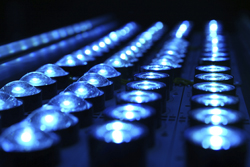Turn on the lights
As energy efficiency and a cleaner environment become a requirement of modern life, scientists are researching novel super-efficient ways to illuminate our homes and workplaces. One idea worth investigating is the use of nanorods, or more specifically of nano-structured gallium nitride-based semiconductors to create clean and inexpensive lighting. The EU-funded project 'Smart nanostructured semiconductors for energy-saving light solutions' (SMASH) aimed to use these nanorods to upgrade existing LED technology. It worked on resolving structural, optical and electro-optical properties in LED structures, based on passive nanorod templates and on nanoemitters, to develop the appropriate chips for this innovative technology. In more technical terms, the project examined the relationship between the physical structure of the rods and the electronic band structure. It looked at carrier transport through the nanorods and studied their optical properties, investigating as well the device properties of nanorod LEDs. This also involved work on design aspects of the LEDs, particularly the electronic model, electroluminescence spectrum and optical model. In addition, the project team made progress regarding scalable materials technologies based on nanorod coalescence on sapphire and silicon substrates. A major part of SMASH's work focused on building optimal nanoemitters, i.e. fabricating arrays of nanoLEDs with broad emission. This enabled the team to make significant progress in furthering front-end and back-end processes related to the LED fabrication value chain. SMASH lastly advanced processes for nanorod template fabrication and for the eventual manufacture of LEDs. These leaps in research have brought stakeholders much closer to being able to produce more cost-effective and efficient LED technology. While more research is still required before commercialisation can begin, the project team has paved the way for a new lighting source that may soon revolutionise illumination in the 21st century.







